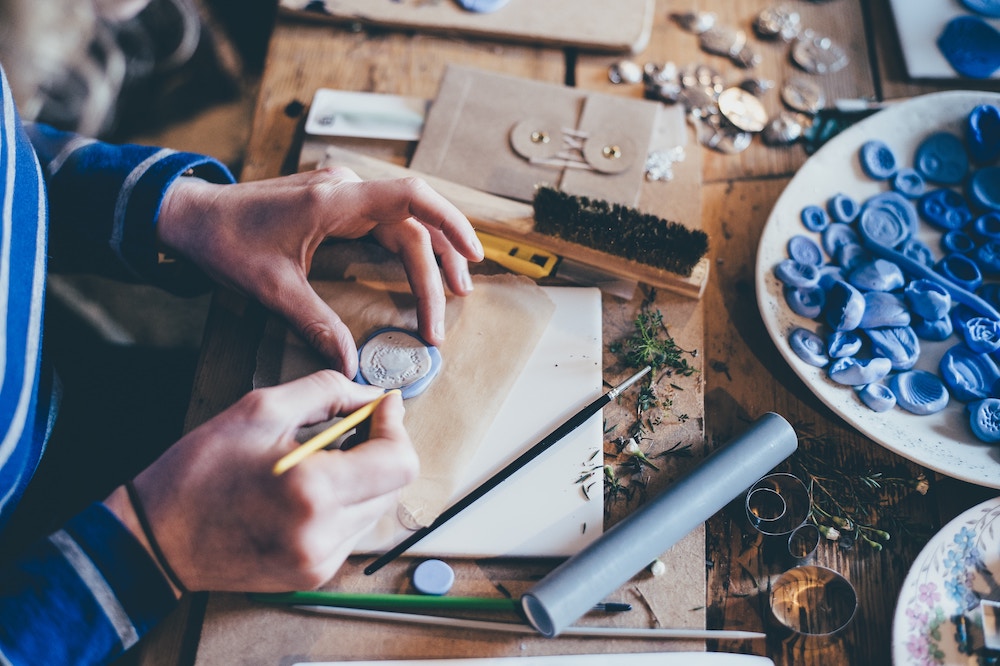Handmade items are the next big thing. It’s more than just a hobby of eco-conscious people; it’s becoming a big business. Which breaks my heart. As someone who loves to handicraft her own things, even knit my own sweaters and scarves, I prefer to buy unique and original items from small businesses. But the trending of handmade items make it difficult at times to get actual ethically hand made items if you aren’t purchasing it from someone you know personally that they are making everything on their own.
When you read a label like “Handmade in Italy” on a new pair of shoes or clothing, what image comes to your mind? You might visualize someone, most likely an older person, crouched over their work table, sewing together each piece by hand, carefully creating the item you’re holding in your hands over long hours. You may presume that since this item was made by hand it was made by an independent artisan or small business, that means it’s made ethically. Or you might even associate it with luxury and high-end brands.

The big question is: What does “handmade” really mean?
Unregulated term often used for “greenwashing”
The popular buzzwords like “local,” “organic,” and “natural” conjure up certain images, which may have little to nothing to do with the actual reality, so does the label “handmade.” As with many unregulated terms, just because an item says it is handmade, that does not mean it was made by the hands selling it or in ethical ways —or it may not have been made by any hands at all. Or not entirely.
About fifteen years ago, the re-introduction of the concept of handmade was radical. The idea that you could make anything by hand (soap, jewelry, handbags, t-shirts, rugs—whatever our grandmothers were able to make themselves) was pretty incredible. In an increasingly automated society that seems to drive all manufacturing overseas to cut costs (think of countries like Peru, Taiwan or Vietnam), the fact that makers were reinventing the manufacturing process at their kitchen tables was revolutionary—only because we forgot how to make these things at home. There’s more access to handmade products now than at any time over the last century. Websites like Etsy were created and every brand seemed to launch a handmade collection to keep up with the trend.
But there is a problem. The terms being unregulated cause issues with being clear of what we get and the policies of websites selling handmade items are not really clear either. While Amazon Handmade “forbid[s] factory-made items of any kind or those made from a kit,” many smaller websites do not. Some other websites and even fairs claim to exhibit and sale handmade goods from independent local artists, it is enough to be a local company if your company is registered there but the products are made elsewhere. This way the product is claimed to be handmade (and it may pretty much be) but you’ll never be able to meet the person who hand-made it. Or in some countries for an item to be called handmade it is enough if the last steps of the creation were done by hand. In the U.K. it is enough for a product to be called “U.K. made” if they transported every ingredient from another country but the final touches, like sticking a label on a jar, were done in the country.
Opaque labor practices
You might be wondering: why is that an issue if the piece is actually handmade? The use of child labor and exploitation of workers is often a problem in the handmade goods industry, especially in developing countries with lower wages.
Until there are better regulations, we cannot know who made the items we purchase and under what circumstances. If you get the chance to talk to the seller, ask directly who actually made that sweater, table or earring. If someone says they designed it, ask if they actually made it themselves, because in some case, the designer and the person who made those items may be different.
What can we do as conscious consumers?
Check the materials
Think about the materials the item was made of. Where did the fabric or material come from? How was it dyed? Are fair trade and labour practices followed in the making? Are they environmentally safe and progressive? Do they provide reusability and recyclability of the product?
I often wonder if the item I bought is really handmade, if it was assembled by hands eventually but the materials used to create it are far from handmade. When you buy handmade, be sure to verify that the products were made with transparent and ethical working standards throughout the entire supply chain. Ethically handmade products also keep customers informed about what they’re buying and lets them choose products according to what is most important to them—whether that means it is organic, recycled, vegan, circular, or more! Look for the FAIRTRADE logo by Fairtrade International, which is a trusted authority for sustainable and ethical production at every stage of the process.
What country was it made in?
Be aware of which countries have the worst workers’ rights record. These include the Middle East, where the kafala system exploits millions of workers as modern slaves, and a number of countries in Africa. Ethical Trade identified some of these countries as Saudi Arabia, Nigeria, Bangladesh, Colombia, Egypt, Guatemala, Kazakhstan, the Philippines, Qatar, South Korea, Turkey, and the United Arab Emirates.
Lastly, think about why you are purchasing an item. There is nothing wrong with purchasing an item because we simply like it, but those of us who want to buy items that are ethically-made and environmentally friendly need to look past the term, “handmade.”
As the above demonstrates, even if an item is made by hand, it may not be made by the hands we assume.
Get more like this—Sign up for our daily inspirational newsletter for exclusive content!
__
Photo: Annie Spratt via Unsplash




